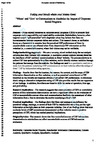Putting your mouth where your money goes! “Where” and “how” to communicate to maximize the impact of corporate social programs
| dc.contributor.author | Siaw, CA | |
| dc.contributor.author | Lie, DS | |
| dc.contributor.author | Govind, R | |
| dc.date.accessioned | 2022-09-29T14:03:54Z | |
| dc.date.available | 2022-09-29T14:03:54Z | |
| dc.date.issued | 2022-09-30 | |
| dc.identifier.issn | 0309-0566 | |
| dc.identifier.issn | 0309-0566 | |
| dc.identifier.uri | http://hdl.handle.net/10026.1/19662 | |
| dc.description.abstract |
The purpose of this study is to examine how corporate communication of their social programs on their websites affects the ratings of those programs by independent rating agencies. Firms expend resources on corporate social programs (CSPs) to promote their corporate social responsibility and sustainability credentials. Stakeholders, however, often respond to such “self-promotion” with skepticism because they believe that there are inconsistencies between corporate claims and actions. This research draws on attribution theory as a framework to examine how the perceived CSP performance of firms by uncontrollable sources are affected when firms disseminate CSP information on firm websites, i.e. a controllable source, where their claims may not be verifiable. Design/methodology/approach: This study uses a two-step, mixed method study for the analysis using data from Fortune 500 companies. A qualitative content analysis process identifies the interfaces of CSP and their communications on firms’ website. The process allows the authors to collect CSP data systematically from firm websites and to identify relevant variables through the patterns that emerge from the analysis. The findings are used in a quantitative analysis to study how the patterns underlying CSP communication on their websites affect the ratings of firms’ CSP by independent rating agencies. Findings: Results show that the location, the manner, the content and the scope of CSP information dissemination on firm websites, as well as perceived commitment to CSP identified on the website are important drivers of perceived CSP performance. A robustness check using an alternative independent rating of CSP also provides results that are supportive of the findings. In addition, the effects are found to differ by sector of operation, firm age and profitability. Research limitations/implications: This research suggests that communication of CSPs at controllable sources of firm information dissemination can have a significant effect on the evaluation of CSP at uncontrollable sources when such communication facilitates the assessment of other information from a firm to determine the motive underlying a firm’s CSP. Practical implications: The findings show that firms and managers can influence the perceived ratings, rankings or scores of their CSP by stakeholders when they put the right information at the right place on their corporate websites. One of the findings shows that even moderate levels of CSP commitment demonstrated on firm websites result in positive perceptions of CSP, which has marked practical implications. Social implications: The findings show that integrating even a medium level of commitment to CSP increases the positive perceptions of a firm’s CSP. Thus, society benefits from the firm’s action without a substantial impact on the firm’s profits. Originality/value: This research shows that firm-controlled sources of CSP information dissemination to stakeholders can affect uncontrollable sources of CSP information evaluation. | |
| dc.format.extent | 3381-3417 | |
| dc.language | en | |
| dc.language.iso | en | |
| dc.publisher | Emerald | |
| dc.subject | Corporate Social Program | |
| dc.subject | Stakeholder Information Dissemination | |
| dc.subject | Content Analysis | |
| dc.subject | Qualitative Analysis | |
| dc.subject | Quantitative Analysis | |
| dc.subject | Corporate Marketing | |
| dc.title | Putting your mouth where your money goes! “Where” and “how” to communicate to maximize the impact of corporate social programs | |
| dc.type | journal-article | |
| dc.type | Journal Article | |
| plymouth.issue | 12 | |
| plymouth.volume | 56 | |
| plymouth.publication-status | Published | |
| plymouth.journal | European Journal of Marketing | |
| dc.identifier.doi | 10.1108/ejm-08-2021-0636 | |
| plymouth.organisational-group | /Plymouth | |
| plymouth.organisational-group | /Plymouth/Faculty of Arts, Humanities and Business | |
| plymouth.organisational-group | /Plymouth/Faculty of Arts, Humanities and Business/Plymouth Business School | |
| plymouth.organisational-group | /Plymouth/REF 2021 Researchers by UoA | |
| plymouth.organisational-group | /Plymouth/REF 2021 Researchers by UoA/UoA17 Business and Management Studies | |
| plymouth.organisational-group | /Plymouth/Users by role | |
| plymouth.organisational-group | /Plymouth/Users by role/Academics | |
| dcterms.dateAccepted | 2022-09-05 | |
| dc.rights.embargodate | 2022-10-1 | |
| dc.identifier.eissn | 0309-0566 | |
| dc.rights.embargoperiod | Not known | |
| rioxxterms.versionofrecord | 10.1108/ejm-08-2021-0636 | |
| rioxxterms.licenseref.uri | http://www.rioxx.net/licenses/all-rights-reserved | |
| rioxxterms.type | Journal Article/Review |


